Louise Danse | |
|---|---|
| Marie-Louise Danse | |
 | |
| Born | 2 April 1867 Saint-Gilles, Belgium |
| Died | 25 May 1948 (aged 81) Saint-Gilles |
| Known for | Painting, etching |
| Spouse | Robert Sand |
Louise Danse (1867 – 1948) was a Belgian painter. [1]
Louise Danse | |
|---|---|
| Marie-Louise Danse | |
 | |
| Born | 2 April 1867 Saint-Gilles, Belgium |
| Died | 25 May 1948 (aged 81) Saint-Gilles |
| Known for | Painting, etching |
| Spouse | Robert Sand |
Louise Danse (1867 – 1948) was a Belgian painter. [1]
She was the daughter of the engraver Auguste Danse who was her first teacher. Her sister Marie Danse was also a painter. Her mother was the sister of the painter Constantin Meunier. Louise was a painter but is better known for her etchings, which were published by her husband, the publisher Robert Sand (1876-1936).
Her etching Portrait of Mlle. Dethier, was included in the 1905 book Women Painters of the World . [2]
She became a founding member of the Brussels graphic artist collective L’Estampe in 1906, along with her sister Marie and her husband, who became the group's secretary.
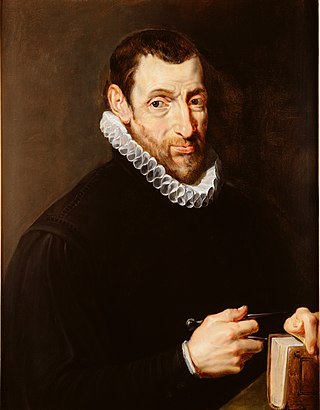
Christophe Plantin was a French Renaissance humanist and book printer and publisher who resided and worked in Antwerp. He established in Antwerp one of the most prominent publishing houses of his time, the Plantin Press. It played a significant role in making Antwerp a leading centre of book publishing in Europe. The publishing house was continued by his successors until 1867.

Philip Fruytiers (1610–1666) was a Flemish Baroque painter and engraver. Until the 1960s, he was especially known for his miniature portraits in watercolor and gouache. Since then, several large canvases signed with the monogram PHF have been ascribed to him. These new findings have led to a renewed appreciation for his contribution to the Antwerp Baroque.
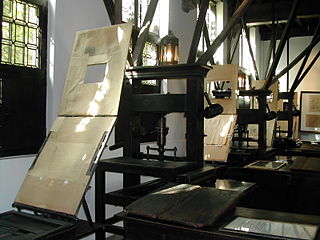
The Plantin Press at Antwerp was one of the focal centers of the fine printed book in the 16th century.

The Cathedral of St. Michael and St. Gudula, usually shortened to the Cathedral of St. Gudula or St. Gudula by locals, is a medieval Catholic cathedral in central Brussels, Belgium. It is dedicated to Saint Michael and Saint Gudula, the patron saints of the City of Brussels, and is considered to be one of the finest examples of Brabantine Gothic architecture.

James Sidney Edouard, Baron Ensor was a Belgian painter and printmaker, an important influence on expressionism and surrealism who lived in Ostend for most of his life. He was associated with the artistic group Les XX.
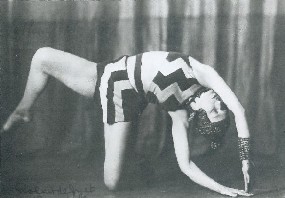
Marguerite Acarin was a Belgian dancer, choreographer, and artist.

Fanny Geefs (1807–1883) was a Belgian painter of Irish descent.
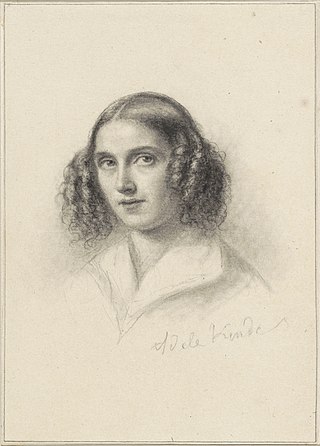
Adèle Kindt was a Belgian painter; known primarily for portraits and genre scenes.

Sophie Rude was a French painter.
Victor Delhez, best known for his woodcut engravings, was born in Antwerp, Belgium, and died in Mendoza, Argentina.

Marie Bracquemond was a French Impressionist artist. She was one of four notable women in the Impressionist movement, along with Mary Cassatt (1844–1926), Berthe Morisot (1841–1895), and Eva Gonzalès (1847–1883). Bracquemond studied drawing as a child and began showing her work at the Paris Salon when she was still an adolescent. She never underwent formal art training, but she received limited instruction from Jean-Auguste-Dominique Ingres (1780–1867) and advice from Paul Gauguin (1848–1903) which contributed to her stylistic approach.

Marie Danse or Marie Destrée-Danse was a Belgian painter-etcher and the wife of the art historian and politician Jules Destrée.

Jozef Linnig or Jan Theodoor Jozef Linnig was a Belgian painter, watercolorist, engraver, art historian and art dealer. He is best known for his drawings of the old quarters of Antwerp and is considered the topographer of old Antwerp. He also co-authored a book on 19th-century Dutch and Belgian painter-engravers.
The following lists events that happened during 1888 in the Kingdom of Belgium.
Events in the year 1877 in Belgium.

Martina Plantin (1550–1616) was involved in her father's printing business from five years of age, and ran the family lace shop from the age of 17. After her father and husband had died, she was the head of the Plantin-Moretus printing business from 1610 to 1614, with daily operations managed by her sons Balthasar and Jan. She was considered a "formidable businesswoman from the wealthy bourgeoisie" and the head of the Plantin-Moretus printing dynasty, by marrying Jan Moretus and being the daughter of publisher Christophe Plantin.
Jacob van Werden or Jacques van Weerden, was a Flemish draughtsman, cartographer, military engineer and archer who was active in the Habsburg Netherlands. His drawings were used as designs for prints executed by various printmakers. He worked on maps, topographical views, historical scenes, portraits and book illustrations. He had a career as a military engineer and a member of the guard of the Spanish King. He advised on various military engineering projects and was an engineer of the army of the Spanish army under Archduke Leopold Wilhelm of Austria at the siege of Landrecies in 1648.

Balthasar van Meurs or Balthazar van Meurs was a Flemish painter and draughtsman. He was a member of a family of printers and publishers which was connected to the Moretus family, which operated the Plantin Press in Antwerp. He was principally a painter of portraits and his principal patrons were the Moretus family.
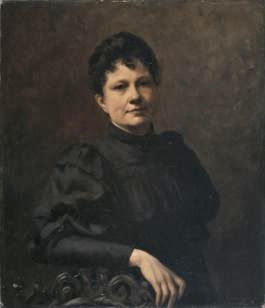
Emma De Vigne was a Belgian still life and portrait painter, who came from a family of artists from Ghent. Her paintings were exhibited in Europe, as well as in South America.
Jean-Baptiste de Dobbeleer-Dellafaille, born on 22 June 1784 in Brussels and died on 21 December 1868 in Saint-Josse-ten-Noode, was a Belgian architect.